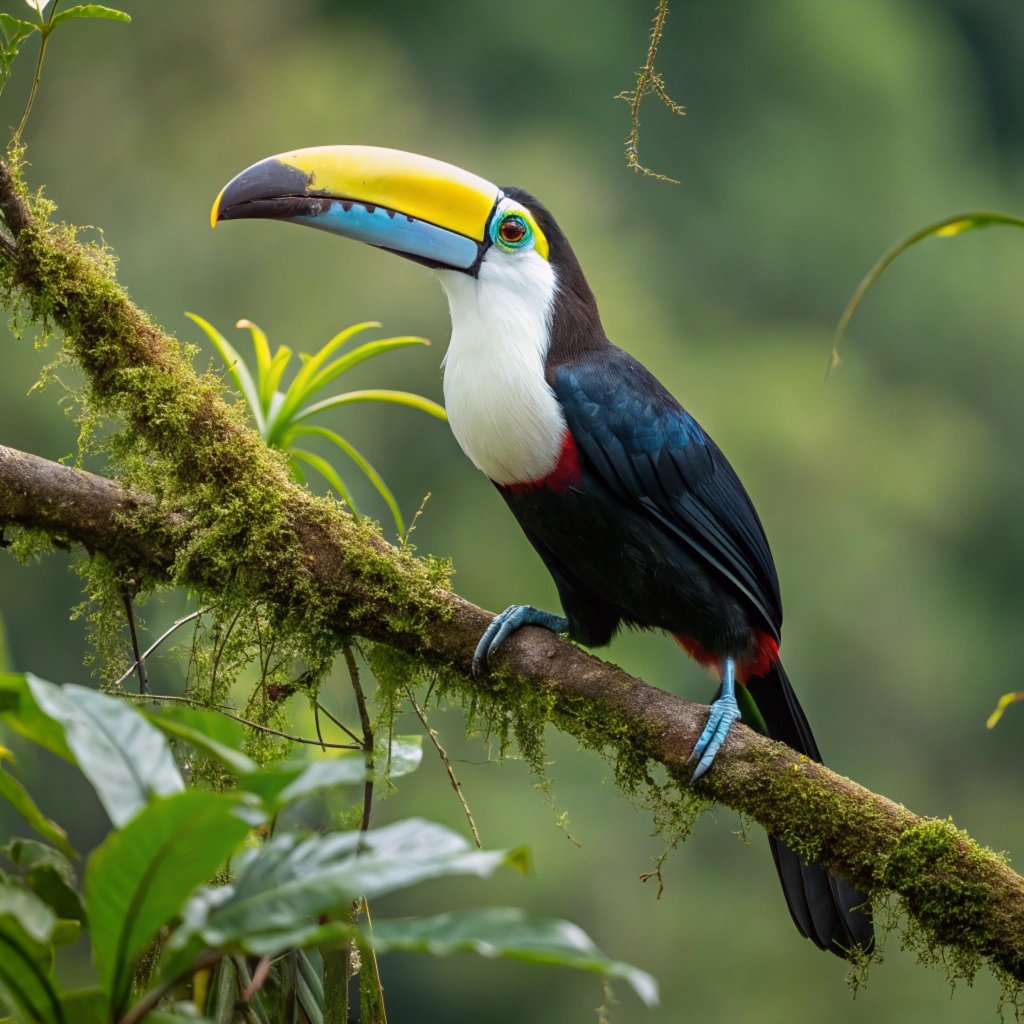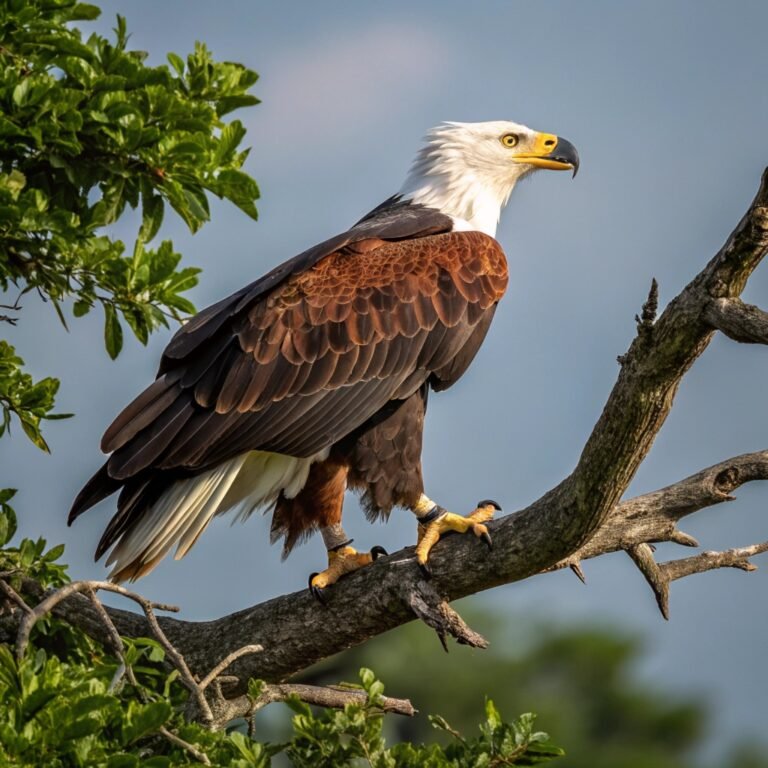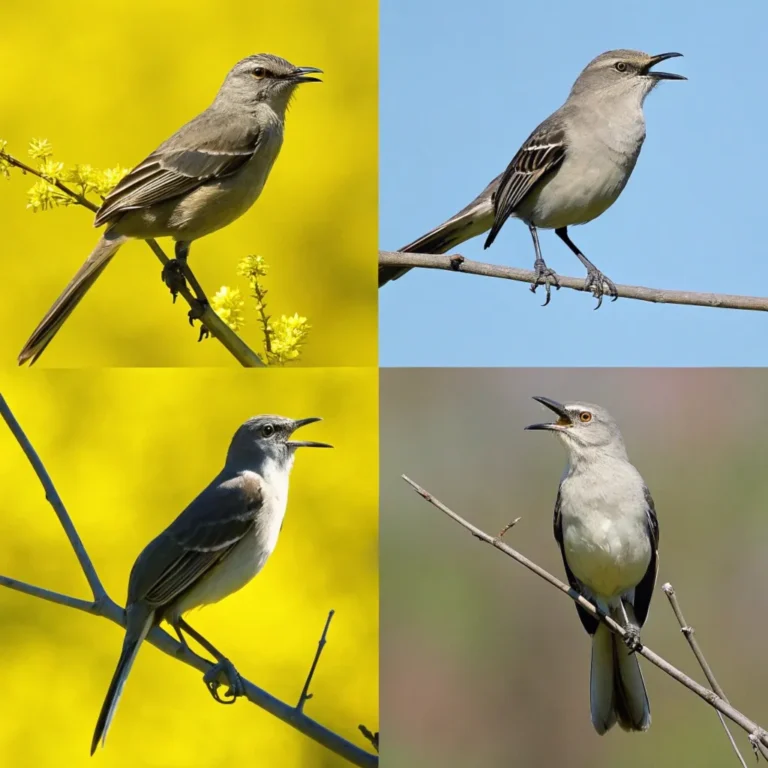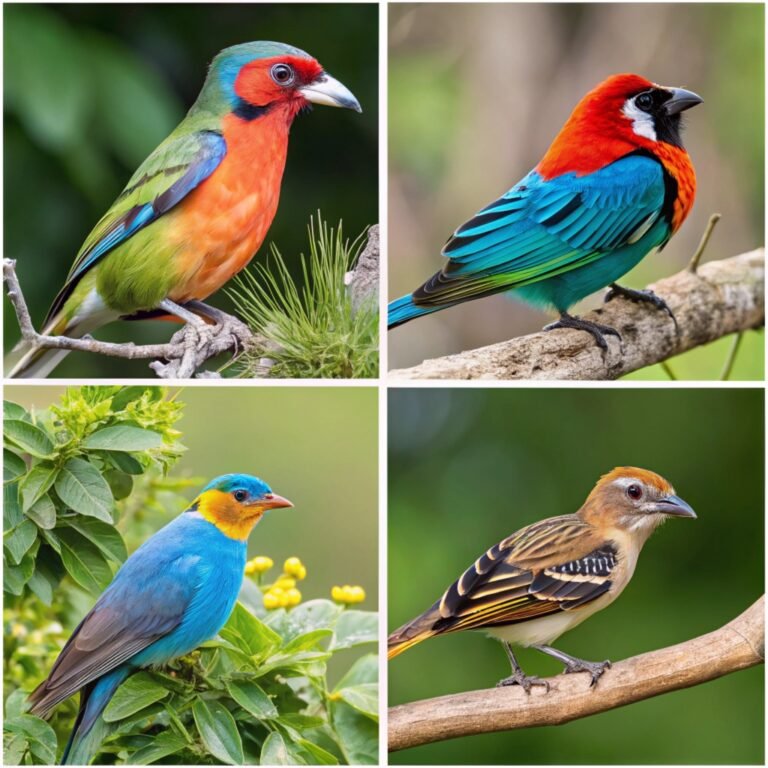The Majestic White-Throated Toucan: This Unique and Enigmatic Species of the Amazon Rainforest
The White-throated Toucan (Ramphastos tucanus) is a captivating and distinctive bird species that inhabits the lush rainforests of South America.
With its striking appearance and fascinating behaviors, this near-passerine bird has captured the imagination of nature enthusiasts and researchers alike.
In this comprehensive guide, we’ll delve into the world of the White-throated Toucan, exploring its physical characteristics, habitat, diet, behavior, and conservation status.

Key Takeaways:
- The White-throated Toucan is a large, colorful bird native to South American rainforests.
- It has a distinctive white throat and a large, colorful bill with shades of yellow, green, and orange.
- These toucans primarily inhabit tropical humid forests in the Amazon Basin and surrounding areas.
- They are frugivorous, mainly feeding on fruits, but also consume insects, small reptiles, and occasionally small birds.
- White-throated Toucans live in small flocks and are monogamous, forming lifelong pairs.
- The species faces threats from deforestation, hunting, and the illegal pet trade.
- Conservation efforts are crucial to protect this unique and iconic bird species.
- They play an important role in seed dispersal within their ecosystem.
- White-throated Toucans have a lifespan of approximately 20 to 26 years in the wild.
- Their large bill serves multiple purposes, including foraging, thermoregulation, and courtship displays.
Physical Characteristics: A Striking Appearance
The White-throated Toucan boasts a remarkable appearance that sets it apart from other bird species.
Its most notable feature is the large, colorful bill, which can measure up to one-third of the bird’s total length. The bill is adorned with vibrant shades of yellow, green, and orange on the upper part, creating a stunning visual display.
The bird’s body is predominantly black, contrasting beautifully with its eponymous white throat. This distinctive white patch is the key identifying feature of the species.
In terms of size, White-throated Toucans are substantial birds, weighing between 500 to 830 grams (1.1 to 1.83 pounds) and measuring 50 to 61 cm (19.5 to 24 inches) in length.
Their large size and colorful plumage make them easily recognizable in their natural habitat.
The combination of the black body, white throat, and vibrant bill creates a visually striking appearance that has made the White-throated Toucan an iconic symbol of the Amazon rainforest.
The White-throated Toucan (Ramphastos tucanus) is a remarkable bird species that captivates the imagination of nature enthusiasts and researchers alike.
This iconic inhabitant of the Amazon rainforest boasts a striking appearance, with its large, colorful bill and distinctive white throat patch contrasting beautifully against its predominantly black plumage.
As a key player in the complex ecosystem of the Amazon Basin, the White-throated Toucan fulfills several crucial roles that contribute to the health and biodiversity of its habitat.
Habitat and Distribution: Thriving in the Amazon Basin

The White-throated Toucan is primarily found in the vast Amazon Basin of South America, including countries such as Brazil, Venezuela, Colombia, Peru, and Bolivia.
These birds have adapted to thrive in tropical humid forests, which provide the ideal environment for their survival.
The dense canopy of the rainforest offers both protection from predators and abundant food sources.
While they prefer the lush, moist forests of the Amazon, White-throated Toucans have shown remarkable adaptability to various habitats.
They can also be found in woodlands and, in some cases, riverine forests within cerrado ecosystems.
This flexibility in habitat selection has allowed the species to maintain a wide distribution across South America.
However, their strong association with tropical forests makes them particularly vulnerable to the ongoing deforestation in the Amazon region, which poses a significant threat to their long-term survival.
Feeding Habits and Diet: Frugivorous with a Twist
White-throated Toucans are primarily frugivorous, meaning their diet consists mainly of fruits. Their large, specialized bill is perfectly adapted for plucking and manipulating fruits from trees.
These birds play a crucial role in their ecosystem as seed dispersers, helping to maintain the biodiversity of the rainforest by spreading seeds from the fruits they consume.
While fruits make up the bulk of their diet, White-throated Toucans are not strictly vegetarian.
They supplement their fruit intake with a variety of other food sources, including insects, small lizards, eggs, and occasionally small birds.
This diverse diet provides them with the necessary nutrients and protein to thrive in their forest habitat.
Their ability to consume a wide range of food items demonstrates their adaptability and contributes to their success as a species in the complex rainforest ecosystem.
These majestic birds are primarily frugivorous, relying heavily on a diet of fruits found throughout the rainforest canopy.
Their large, specialized bills are perfectly adapted for plucking and manipulating fruits from trees, allowing them to access food sources that may be out of reach for other species.
Behavior and Social Structure: Life in the Canopy
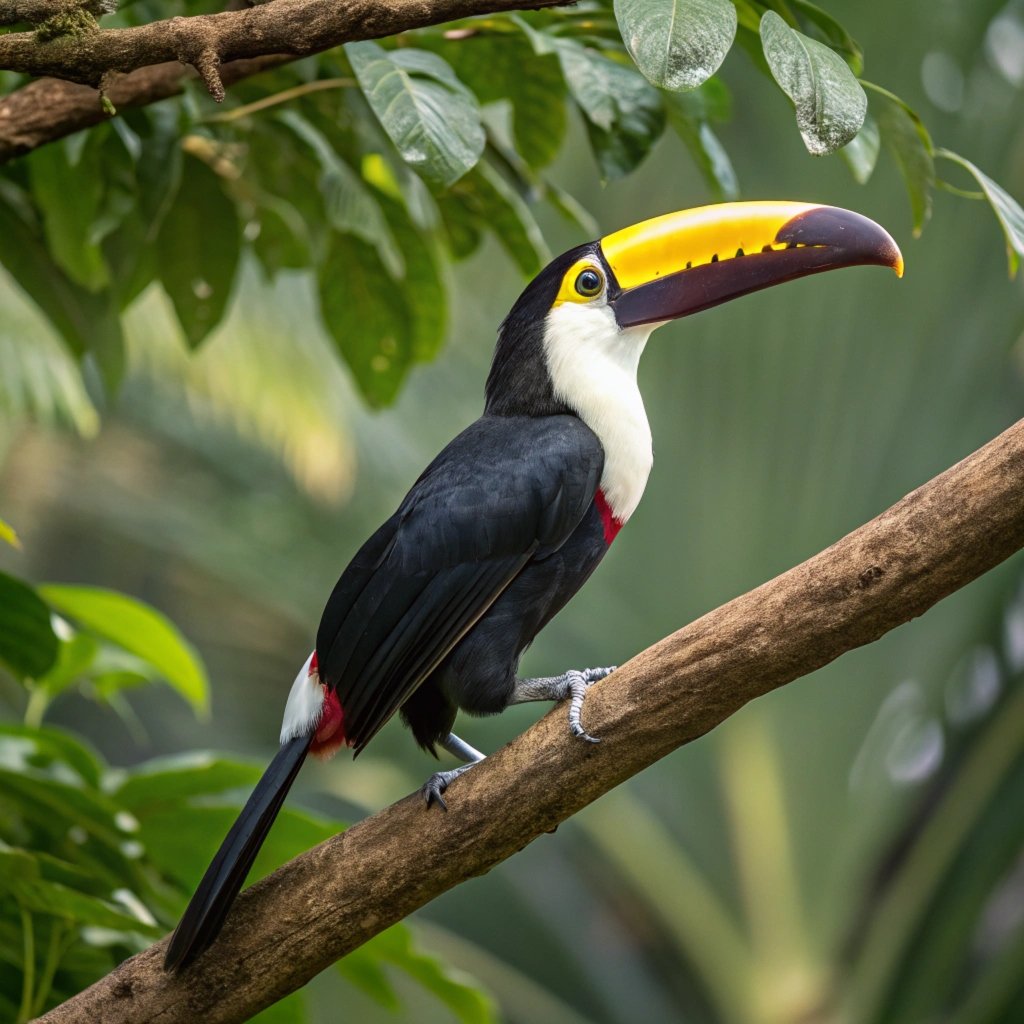
White-throated Toucans are arboreal birds, spending most of their time in the upper canopy of the rainforest.
They move through the trees with a distinctive flight pattern, described as heavy and undulating.
These birds typically fly short distances, rarely traveling more than 100 meters (330 feet) at a time. This behavior is likely an adaptation to conserve energy and navigate the dense forest environment efficiently.
Socially, White-throated Toucans are often observed in small flocks or pairs. These groups work together to search for food and protect each other from potential predators.
The birds communicate using a variety of loud, distinctive calls that can be heard echoing through the rainforest.
These vocalizations play a crucial role in maintaining social bonds, defending territory, and attracting mates.
This dietary preference makes White-throated Toucans important seed dispersers, playing a vital role in maintaining the biodiversity of the rainforest by spreading seeds from the fruits they consume.
As they move through their habitat, they effectively plant new trees and contribute to the regeneration of the forest.
While fruits form the bulk of their diet, White-throated Toucans demonstrate remarkable adaptability in their feeding habits.
Reproduction and Breeding: A Cooperative Effort
White-throated Toucans are monogamous birds, forming long-term pair bonds that often last for life. The breeding season typically coincides with the availability of fruits in their habitat.
When it’s time to nest, these toucans seek out tree cavities, often using abandoned woodpecker nests or natural hollows in decayed sections of living trees.
The female usually lays 2 to 4 white eggs in the unlined cavity. Both parents share the responsibilities of incubation, which lasts for approximately 14 to 20 days.
After hatching, the chicks are born blind and naked, with short bills and specialized pads on their heels to protect them from the rough nest floor.
Both parents continue to care for the young, feeding them regurgitated food for about six weeks until they fledge.
Even after leaving the nest, juvenile toucans may receive parental care for several additional weeks.
They supplement their fruit intake with a variety of other food sources, including insects, small lizards, eggs, and occasionally small birds.
This diverse diet provides them with the necessary nutrients and protein to thrive in their forest habitat, showcasing their ability to adapt to the available resources in their environment.
Conservation Status and Threats: Facing Challenges in a Changing World
The conservation status of the White-throated Toucan varies depending on the specific subspecies and region.
While some populations are considered of Least Concern, others have been classified as Vulnerable.
The primary threat facing these magnificent birds is the accelerating deforestation in the Amazon basin, which is rapidly destroying and fragmenting their natural habitat.
In addition to habitat loss, White-throated Toucans face other significant challenges. Hunting pressure continues to impact their populations, either for traditional uses or to meet the demand for exotic pets.
The illegal pet trade poses a particular threat, as these colorful and charismatic birds are often targeted for capture and sale in the international market.
Climate change is another looming threat that could affect the White-throated Toucan’s habitat and food sources in the long term.
Changes in temperature and precipitation patterns may alter the availability of fruits and other resources that these birds depend on for survival.
The social behavior of White-throated Toucans is equally fascinating. These birds are often observed in small flocks or pairs, working together to search for food and protect each other from potential predators.
Their loud, distinctive calls echo through the rainforest, serving multiple purposes in their daily lives.
These vocalizations play a crucial role in maintaining social bonds, defending territory, and attracting mates.
Importance in the Ecosystem: More Than Just a Pretty Bird
White-throated Toucans play a vital role in maintaining the health and biodiversity of their rainforest habitat.
As frugivores, they act as important seed dispersers, helping to spread the seeds of various plant species throughout the forest.
This function is crucial for forest regeneration and the maintenance of plant diversity.
The presence of White-throated Toucans in an ecosystem can also serve as an indicator of forest health.
Their reliance on a diverse array of fruits and their sensitivity to habitat changes make them excellent barometers for the overall condition of the rainforest.
By monitoring toucan populations, researchers can gain valuable insights into the health of the broader ecosystem.
The ability to produce these far-carrying sounds is particularly important in the dense rainforest environment, where visibility is often limited.
In terms of reproduction, White-throated Toucans exhibit monogamous behavior, forming long-term pair bonds that often last for life.
The breeding season typically coincides with the availability of fruits in their habitat, ensuring that there are ample resources to support the raising of young.
Adaptations and Unique Features: The Remarkable Toucan Bill
One of the most fascinating aspects of the White-throated Toucan is its large, colorful bill. This remarkable adaptation serves multiple purposes beyond simply foraging for food.
The bill plays a crucial role in thermoregulation, helping the bird regulate its body temperature in the hot and humid rainforest environment.
The large surface area of the bill allows for efficient heat exchange, helping the toucan cool down when necessary.
The bill also plays a significant role in courtship displays and social interactions. Male toucans often use their bills in ritualized behaviors to attract mates and establish dominance.
The vibrant colors and patterns on the bill may also serve as visual signals to other toucans, conveying information about the bird’s health, age, or social status.
Both parents share the responsibilities of incubation and caring for the chicks, demonstrating a high level of parental investment in their offspring.
Despite their adaptability and important ecological role, White-throated Toucans face significant challenges in the modern world.
The primary threat to their survival is the accelerating deforestation in the Amazon basin, which is rapidly destroying and fragmenting their natural habitat.
Vocalizations and Communication: The Sounds of the Rainforest
White-throated Toucans are known for their distinctive vocalizations, which play a crucial role in their social interactions and survival in the dense rainforest.
Their calls have been described as a series of loud, guttural croaks or yelping sounds, often likened to the sound of frogs or small dogs. These vocalizations serve multiple purposes, including:
- Territory defense: Male toucans use their calls to establish and maintain territories, warning off potential intruders.
- Mate attraction: During breeding season, toucans use specific calls to attract and court potential mates.
- Group coordination: When foraging in small flocks, toucans use vocalizations to keep in contact with each other and coordinate their movements.
- Alarm calls: Toucans have distinct alarm calls to warn others of potential predators or threats in the area.
The ability to produce these loud, far-carrying sounds is particularly important in the dense rainforest environment, where visibility is often limited.
By using vocalizations, White-throated Toucans can effectively communicate over long distances, maintaining social bonds and ensuring the safety of their group.
Interactions with Humans: Cultural Significance and Ecotourism
The striking appearance and charismatic nature of the White-throated Toucan have made it an important cultural symbol in many South American countries.
These birds often feature in indigenous art, folklore, and traditional stories, representing the beauty and diversity of the rainforest.
In recent years, the White-throated Toucan has become an important species for ecotourism in the Amazon region. Birdwatchers and nature enthusiasts from around the world travel to catch a glimpse of these magnificent birds in their natural habitat.
This growing interest in toucan-watching has the potential to contribute to conservation efforts by providing economic incentives for local communities to protect the rainforest and its inhabitants.
However, it’s crucial that any ecotourism activities are conducted responsibly and with minimal impact on the toucans and their habitat.
Sustainable tourism practices can help raise awareness about the importance of conserving these unique birds and their rainforest home.
This loss of habitat not only directly impacts the toucans but also disrupts the delicate balance of the entire ecosystem they inhabit.
Additionally, these beautiful birds face pressure from hunting and the illegal pet trade, further straining their populations.
The conservation of White-throated Toucans is crucial not only for the survival of the species itself but also for the health of the entire Amazon rainforest ecosystem.
As indicator species, the presence and abundance of toucans can provide valuable insights into the overall health of the forest.
Conservation Efforts: Protecting the Future of White-throated Toucans
Given the threats facing White-throated Toucans, conservation efforts are crucial to ensure the long-term survival of the species. Several initiatives are currently underway to protect these birds and their habitat:
- Habitat protection: Efforts to establish and maintain protected areas in the Amazon rainforest are vital for preserving toucan habitat.
- Anti-poaching measures: Increased enforcement and penalties for illegal hunting and trapping of toucans can help reduce the impact of the pet trade.
- Research and monitoring: Ongoing studies of toucan populations and behavior provide valuable data for conservation planning.
- Community engagement: Involving local communities in conservation efforts and providing alternative livelihoods can help reduce pressure on toucan populations.
- Education and awareness: Raising public awareness about the importance of toucans and the threats they face can help garner support for conservation initiatives.
By implementing these and other conservation strategies, we can work towards ensuring a bright future for the White-throated Toucan and the rich biodiversity of the Amazon rainforest.
Their sensitivity to habitat changes and reliance on a diverse array of fruits make them excellent barometers for assessing the condition of their environment.
FAQs
What is the scientific name of the White-throated Toucan?
The scientific name of the White-throated Toucan is Ramphastos tucanus.
Where can White-throated Toucans be found in the wild?
White-throated Toucans are primarily found in the Amazon Basin of South America, including countries such as Brazil, Venezuela, Colombia, Peru, and Bolivia.
What do White-throated Toucans eat?
White-throated Toucans are mainly frugivorous, feeding primarily on fruits. However, they also consume insects, small lizards, eggs, and occasionally small birds.
How large are White-throated Toucans?
White-throated Toucans typically weigh between 500 to 830 grams (1.1 to 1.83 pounds) and measure 50 to 61 cm (19.5 to 24 inches) in length.
What is the conservation status of the White-throated Toucan?
The conservation status of the White-throated Toucan varies depending on the subspecies and region. Some populations are considered of Least Concern, while others have been classified as Vulnerable.
Why is it important to protect White-throated Toucans?
Protecting White-throated Toucans is crucial for maintaining biodiversity in their natural habitats, preserving healthy ecosystems, and ensuring the survival of this unique and iconic bird species.

Hello, I’m Emily Price, the founder of Birds Affection. As a passionate bird enthusiast and spiritual seeker, I’ve always been fascinated by the symbolic meanings and mystical connections between birds and our lives. On this website, I share my knowledge and insights on the spiritual significance of various bird species, exploring their roles as messengers, guides, and teachers. Through my writing, I aim to inspire and educate others on the profound wisdom and beauty that birds bring to our world. Join me on this journey as we delve into the enchanting realm of bird symbolism and discover the hidden meanings behind these magnificent creatures.

